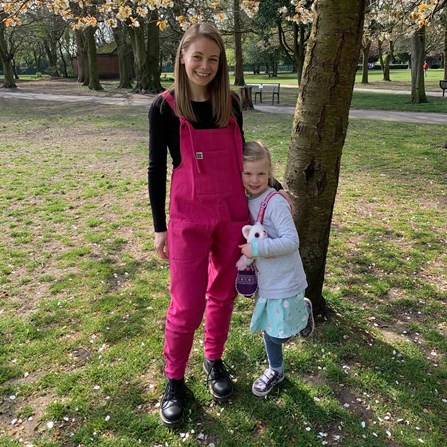What I wish people knew about communicating with my daughter
Published Date: 04 May 2021
Our daughter, Sybil, was born profoundly deaf due to Auditory Neuropathy Spectrum Disorder (ANSD) and uses bilateral cochlear implants to hear. Although she’s five years old, Sybil has only had access to sound through her implants since she was 18 months old, so her ‘listening age’ is 3.5 years. Sybil learnt to listen through intensive Auditory Verbal Therapy (AVT) sessions and she’s done amazingly well to catch up with her hearing peers; she truly makes listening look effortless. However, it’s not effortless at all, and like all deaf children, Sybil expends a huge amount of energy focusing and concentrating on conversations and interactions.
Some simple deaf awareness techniques can really help make things easier for her, so here are my top tips for communicating with my deaf child.
My number one tip is the golden rule, if you remember only one thing, make it this! Always make sure you get Sybil’s attention before you start speaking or signing to her. It’s such a simple thing that so many people (including myself at times) forget when interacting with her. It can be as simple as a tap on the arm, saying her name or waving your hand at her. Listening is a very active process for deaf children, so without making sure that she is focused on you, it’s very easy for her to miss everything that’s said, or only tune in halfway through the sentence, forcing her to have to play catch up and guess at what was said – exhausting!
If you’re not sure whether or not Sybil heard you, there’s no problem in repeating yourself, saying something in a slightly different way, or asking an open-ended question to check her understanding, but please don’t dumb it down! I’ve got a very bright and inquisitive child who needs to be exposed to new vocabulary and speakers all the time in order to challenge and stretch her. We always hugely appreciate people who take the time to chat to her. Don’t worry if it takes a few tries to get going – unfamiliar voices and different accents can be tricky, and it can take Sybil a little while to ‘tune in’, but these are very important interactions for her.
There’s no need to shout or over-enunciate when you’re talking to Sybil, a clear voice is all you need. Bonus points are given for ensuring that you’re facing her and she can see your face and lips well, so try to make sure your mouth is uncovered and well lit. That’s easier said than done at the moment, with facemasks currently being such a big part of our lives! In fact, I think the widespread adoption of face masks has shown many hearing people that we all rely on clear facial expressions and lip-patterns to be able to communicate well. The difficulties with masks – muffled sounds, unclear expressions, no lip-patterns – have been mildly irritating at worst for hearing people, but for deaf people these problems can result in isolation and huge amounts of frustration. So, only if you’re comfortable, please step back and then lower your mask when talking to Sybil.
Sometimes you can do absolutely everything right, but the background noise just makes it really tricky for Sybil to hear, as her cochlear implants amplify every sound, not just speech. In this case, getting slightly closer and coming down to her level can help, or move to a quieter place if possible. Trying out some signs, if you know any, would be really helpful. If not, natural gestures can help here too.
It really is as simple as that to be more deaf aware!
